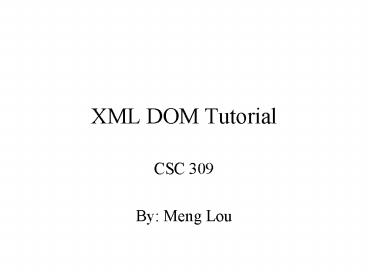XML DOM Tutorial - PowerPoint PPT Presentation
1 / 16
Title:
XML DOM Tutorial
Description:
walk(child); //without this the ending tags will miss. if ( type ... end of walk. DOM or SAX ? Dom - Suitable for small documents - Easily modify document ... – PowerPoint PPT presentation
Number of Views:337
Avg rating:3.0/5.0
Title: XML DOM Tutorial
1
XML DOM Tutorial
- CSC 309
- By Meng Lou
2
DOM
- Introduction
- Overview
- Steps for DOM parsing
- Examples
- DOM or SAX?
- Summary
3
Introduction
- DOM supports navigating and modifying XML
documents. - Hierarchical tree representation of documents
- Language Neutral, C, Java, CORBA
- www.w3c.org/DOM
4
Pros and Cons
- Advantages Robust API for the DOM TREE
Relatively simple to modify the data structure
and extract data - Disadvantages Stores the entire document in
memory As DOM was written for any language,
method naming conventions dont follow standard
Java conventions
5
Overview of steps
6
Steps for parsing
- Specify parser
- Create a document builder
- Invoke the parser to create a Document
representing the XML document - Normalize
- Obtain the root node
- Modify and examine the properties of nodes
7
8
Specifying a Parser
- Use the command line java D option
- In the program, use System.setProperty, eg.
- System.setProperty( javax.xml.parsers.DocumentB
uilderFactory, org.apache.xerces.jaxp.DocumentBu
ilderFactoryImpl )
9
Create a Document Handler
- Create an instance of builder factory, then use
it to create a DocumentBuilder Object - DocumentBuilderFactory builderFactory
DocumentBuilderFactory.newInstance() - DocumentBuilder builder builderFactory.newDocum
entBuilder()
10
Create a Dcoument
- Call the parse method
- Document doc builder.parse (someInputStream)
- The Document class represents the parsed result
in a tree structure
11
Normalize the Tree
- Normalization has two affects
- - Combines textual nodes that span multiple
lines - - Eliminates empty textual nodes
- doc.getDocumentElement().normalize()
12
Obtain the root node
- Traversing begins at the root node
- Element rootElement doc.getDocumentElement()
- - Element is a subclass of the more general Node
class represents an XML element - - Node represents all the various components of
an XML document - eg. Document, Element, Attribute, Entity
13
Examine and Modify Nodes
- Various properties
- - getNodeName
- - getNodeType
- - getAttributes
- - getChildNodes
- - setNodeValue
- - appendChild
- - removeChild
- - replaceChild
14
Sample Code Bits
- //walk the DOM tree and print as u go
- public void walk(Node node)
- int type node.getNodeType()
- switch(type)
- case Node.DOCUMENT_NODE
- System.out.println("lt?xml
version\"1.0\" encoding\"" - "UTF-8"
"\"?gt") - break
- //end of document
- case Node.ELEMENT_NODE
- System.out.print('lt'
node.getNodeName() ) - NamedNodeMap nnm
node.getAttributes() - if(nnm ! null )
- int len nnm.getLength()
15
DOM or SAX ?
- Dom
- - Suitable for small documents
- - Easily modify document
- - Memory intensive
- SAX (Simple API for XML)
- - Suitable for large documents
- - Only traverse document once
- - event Driven, saves memory
16
Summary
- DOM is a tree representation of an XML document
in memory - JAXP provides a vendor-neutral interface to the
underlying parser - Every component of the XML document is a Node
- Use normalization to combine text elements that
spans multiple lines































